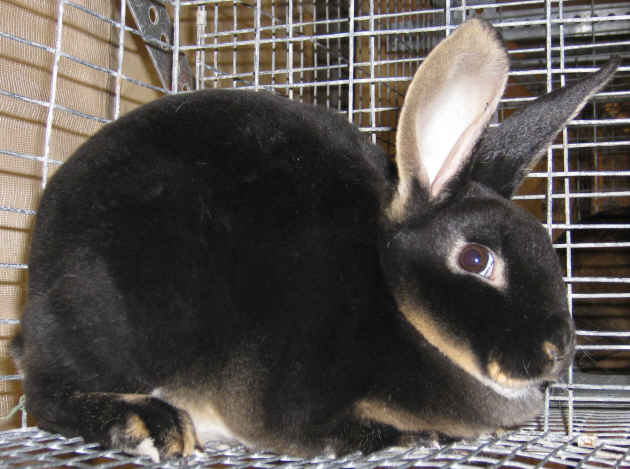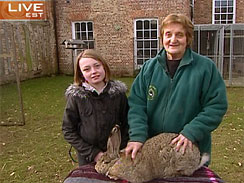

~ Rabbit Rhythm - a Part of Life ~It’s March...nearly springtime. Our rabbits have been feeling amorous since early February. It’s the lengthening daylight hours that signal to the rabbits that soon the earth will be covered in fresh green grasses and new buds on bushes - great nourishment for a doe and her litter (in the wild). Your does might be feeling their hormones! They want to breed. Their hormones might be driving them nuts. If you reach into their cage and they lift their hind-ends...if they seem a big growly, or even take a nip at you...they’re wishing you were a handsome buck. Breeding Tips:
In the News LatelyIn the news lately:CBS aired the following story about a huuuuge rabbit on the Early Show, Feb 19, 2010 - perhaps you saw it?
Ralph is a continental giant - colossal indeed! He’s a 42 pound rabbit, 4 feet long all stretched out, and he eats 4 pounds of food a day. Yet he doesn’t appear to be overweight in the picture - what do you think? The woman, Pauline Grant, of Uckfield, England, purchased a little bunny for her grandkids to play with, thinking it would be a typical normal rabbit. What she didn’t realize, and the breeders may have failed to tell her, was that the "bunny" was a British Continental Giant. But other than feeding Ralph enormous amounts of food, it hasn’t been all bad for Pauline. Her granddaughter, Ella McDonnell, says it’s a lot of fun to play with Ralph. News on the Street about Continental Giants: A 'Giant' FYI: And there are some differences. In England, the BRC grants more points to the biggest rabbits. In the USA, the Flemish Giant standard of perfection simply calls for a weight over 14 pounds (does). Because of these differences, the propensity for large sizes has been built into the genetic makeup of continental giants. Flemish Giants still grow plenty big, but more Continental giants become truly...gigantic. Tips:
Understanding Rabbit TeethALL the teeth in a rabbit's mouth - all 28 of them - continually grow, not just the front four that you can readily see.Without sufficient fiber to wear down the rabbit's teeth, some big problems can result. Tooth roots can grow too deeply into the jawbones, causing pain and difficulty chewing food. With teeth problems, the rabbit loses weight, may start slobbering, and may develop jaw abscesses which weaken the immune system. Uncared for, the rabbit can die from the abscess, or from an unrelated illness due to a general rundown condition. The immune system can only fight infection for so long, and then it runs out of ammunition. Tips:
Picture of the Month This is our black otter doe, "Damask," at approximately 3 1/2 months old. She has since become a grand champion. We’re quite pleased with her! Send us pics of your bunny, your backyard rabbitry, your best show rabbit, or even your worst. Tell us the story of your picture in a few words - we’ll pick the fave and publish it in next month’s Rabbit Rhythm.
Last But Not LeastRaising-Rabbits Preview:Psst - Coming soon to www.raising-rabbits.com - Write your own pages and make comments on most everything! Projected go-live date is March 12, 2010, or before. Come visit soon, and join in the rhythm! New content: Next month’s topic: Like this newsletter? Share it with your friends! New! CommentsHave your say about what you just read! Leave me a comment in the box below. |

